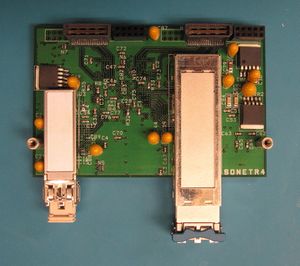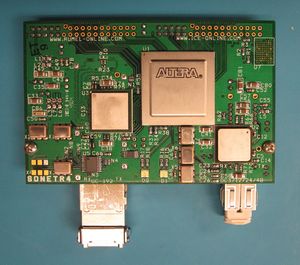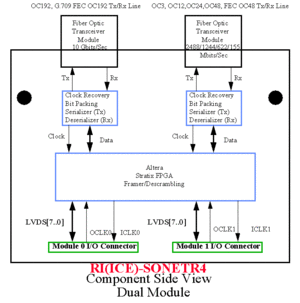ICE-SONET-r4
Contents
Features
- Bidirectional, interfaces to STM1, STM4, STM8, STM16, STM64, OC3, OC12, OC24, OC48, and OC192
- Accepts G.709 FEC OC192 Input and G.709 FEC OC48 Input
- Provides byte packing, frame alignment, and descrambling
- Dual-site module, takes up both input and output ports on ICE-PIC6 card
- Port 1 provides STM64 BiDir fiber interface
- Port 2 provides STM1, STM4, STM8, and STM16 BiDir fiber interface
- INPUT: Port 2 is capable of realtime demux of STM16 to user selectable STM1, STM4, or STM8
- INPUT: Port 1 is capable of realtime demux of STM64 to user selectable STM1, STM4, STM8, or STM16
- OUTPUT: Port 1 is capable of "cloning" STM1, STM4, STM8, and STM16 to STM64
- OUTPUT: Port 2 is capable of "cloning" STM1, STM4, and STM8 to STM16
- Custom subsystems capable of input/output of full STM16 rates are available
Note: For use only with ICE-PIC5XL or ICE-PIC6
Port Modes: Acquisition & Playback
Port 1 SonetR4 acquisition signal types:
- G.709 FEC OC192
- OC192
Port 1 SonetR4 playback signal types:
- OC192
Port 2 SonetR4 acquisition signal types:
- G.709 FEC OC48 (no demuxing)
- OC48
- OC24
- OC12
- OC3
Port 2 SonetR4 playback signal types:
- G.709 FEC OC48 (no cloning)
- OC48
- OC24
- OC12
- OC3
Flag Usage
SonetR4 Side #1 Acquisition/Playback Flags
- OC192: logic signal type OC192
- May be used with G709FEC flag for acquire only, must be used with demux flag
SonetR4 Side #2 Acquisiiton/Playback Flags
- OC48: logical signal type OC48, may be used with either demux flags or G709FEC flag but not both
- OC12: logical signal type OC12, may be used with demux flags
- OC3: logical signal type OC3
Additional Flags For Use with Side #1 or #2 Flags
G709FEC-Input Signal is G.709 FEC Encoded
- For SonetR4 #1 side: must be used with OC192 flag & demux flag
- For SonetR4 #2 side: must be used with OC48 & FRAMINGOFF flags, demux flag not allowed
FRAMINGOFF
Acquire or playback data as it appears on the fiber-optic line. Frame alignment and de-scrambling of data are turned off. This flag may NOT be used with demux/cloning flags.
Demux/Cloning Flag Options For Use with Side #1 or #2 Flags
OC3FROMOCX
- For acquisition: pull out single OC3 stream from either an OC12, OC24, OC48, or OC192 source
- For playback: replicate the data N times within hardware to form a higher rate signal. For OC12 N is 4, OC24 N is 8, OC48 N is 16, and for OC192 N is 64
This flag requires the use of OC12, OC24, OC48, or OC192 flags and OC12, OC24, OC48, or OC192 signal input.
OC3NUM=x
- For acquisition: which OC3 from which to pull OC12, OC24, OC48, or OC192 signal
- For playback: specify any number for x
This flag requires the use of the OC3FROMOCX flag.
Value Range
- Values of x for an incoming/outgoing OC12 are 0 thru 3
- Values of x for an incoming/outgoing OC24 are 0 thru 7
- Values of x for an incoming/outgoing OC48 are 0 thru 15
- Values of x for an incoming/outgoing OC192 are 0 thru 63
OC12FROMOCX
- For acquisition: pull out single OC12 stream from either an OC24 or OC48 source.
- For playback: replicate the data N times within hardware to form a higher rate signal; for OC24 N is 2 and OC48 N is 4
This flag requires the use of OC24, OC48, or OC192 flags and OC24, OC48, or OC192 signal input.
OC12NUM=x
- For acquisition: which OC12 to pull from OC24 or OC48 signal
- For playback: specify any number for x
This flag requires the use of the OC12FROMOCX flag.
Value Range
- Values of x for an incoming/outgoing OC24 are 0 or 1
- Values of x for an incoming/outgoing OC48 are 0 thru 3
- Values of x for an incoming/outgoing OC192 are 0 thru 15
OC24FROMOCX
- For acquisition: pull out single OC24 stream from an OC48 source
- For playback: replicate the data N times within hardware to form a higher rate signal; for OC48 N is 2
This flag requires the use of OC48 or OC192 flag and OC48 or OC192 signal input.
OC24NUM=x
- For acquisition: which OC24 to pull from OC48 signal
- For playback: specify any number for x
This flag requires the use of the OC24FROMOCX flag.
Value Range:
- Values of x for an incoming OC48 are 0 or 1
- Values of x for an incoming OC192 are 0 thru 7
OC48FROMOCX
- For acquisition: pull out single OC48 stream from an OC192 source
- For playback: replicate the data N times within hardware to form a higher rate signal; for OC192 N is 4
This flag requires use of OC192 flag and OC192 signal input.
OC48NUM=x
- For acquisition: which OC48 to pull from OC192 signal
- For playback: specify any number for x
This flag requires the use of the OC48FROMOCX flag.
Value Range: values of x for an incoming OC192 are 0 thru 3.
Examples
Side #1 Acquisition Flag Examples
| G709FEC,OC192,OC48FROMOCX,OC48NUM=0 | Demux 1st OC48 From G.709 FEC Encoded OC192 Input |
| OC192,OC12FROMOCX,OC12NUM=2 | Demux 3rd OC12 From OC192 Input |
| G709FEC,OC192,OC3FROMOCX,OC3NUM=63 | Demux 64th OC3 From G.709 FEC Encoded OC192 Input |
Side #2 Acquisition Flag Examples
| G709FEC,OC48,FRAMINGOFF | Acquire Full G.709 FEC OC48 |
| OC48 | Acquire Full OC48 |
| OC48,OC12FROMOCX,OC12NUM=2 | Demux 3rd OC12 From OC48 Input |
| OC12,OC3FROMOCX,OC3NUM=3 | Demux 4th OC3 From OC12 Input |
Side #1 Playback Flag Examples
| OC192, OC48FROMOCX,OC48NUM=0 | Clone OC48 4 times to produce OC192 For Output |
| OC192,OC3FROMOCX,OC3NUM=0 | Clone OC3 64 times to produce OC192 For Output |
Note: G.709FEC Playback on Port #1 has not yet been implemented and cannot be used.
Side #2 Playback Examples
| G709FEC,OC48,FRAMINGOFF | Playback Full G.709 FEC OC48 |
| OC48 | Playback Full OC48 |
| OC48,OC12FROMOCX,OC12NUM=0 | Clone OC12 4 Times to produce OC48 Output |
| OC12,OC3FROMOCX,OC3NUM=0 | Clone OC3 4 Times to produce OC12 Output |
| OC48,OC3FROMOCX,OC3NUM=0 | Clone OC3 16 Times to produce OC48 Output |
C Program Date: December 27, 2005
Program works with ice318b11 (and higher). Support for SonetR1, R2, R4, and R5 modules. To build the software, copy the zip package to the <install path>/iceXXX/test directory, where <install path> is the directory structure where the ICE software package iceXXX was installed. The directory iceXXX represents the software version; e.g., ice318b11, ice318b18, etc.
Unzip sntcfiles.zip to produce 2 files: testsnt.c and buildsnt.lnx. Finally, to build the software, type source buildsnt.lnx
Sourcing the build script will cause the program testsnt to be built. During compilation of testsnt, progress messages will be printed to the user.
Zipped version of testsnt.c AND buildsnt.lnx: sntcfiles.zip
testsnt C Program Explanation/Examples
New testsnt.c program examples:
./testsnt <mod type> <card number> <"acq" or "play"> <size in GBytes> <loops> <port number><path & filename> <flags> <mod type> module type r1, r2 ,r4, r5 For Sonet Modules SonetR1, SonetR2, SonetR4, SonetR5, respectively <card number> ICE PIC card number in system, 0 for first card, 1 for second card, etc., depending on which card is in use <"acq" or "play"> acq will cause the card/module to acquire data, play will cause the card/module to playback data <size in GBytes> size of acquisition or playback in GBytes <loops> represents the number of times to "loop" through a file for playback, always set = 1 for acquisitions <port number> set to 1 for operation on port 1, set to 2 for operation on port 2, set to 3 for operation on both ports 1 & 2 <path & filename> acq, specify path & filename of where data is to be written or play, path and filename for playback of data <flags> see flag descriptions and examples above
Examples of using the flags above with the testsnt program
The examples make 2 assumptions:
- The OS driver was setup to allocate enough memory for card usage.
- The testsnt program will request the following from the driver:
- 640 MBytes for OC48 rates
- 256 Mbytes for OC24 rates
- 128 MBytes for OC12 rates
- 64 MBytes for OC3 rates
- The testsnt program will request the following from the driver:
- Therefore, for the desired data rate, the driver previously must have been setup to allocate at least the amount requested.
- The disk RAID (mounted on /raid for the examples below) used for acquisitions/playbacks is capable of writing/reading at the example signal rates.
- OC48-320Mbytes/Sec, OC12-80Mbytes/Sec, and OC3-20Mbytes/SEC
Note the use of commas and no spaces between flags at the end of the command line string.
./testsnt r4 0 acq 10 1 1 /raid/xmidas/test1.dat G709FEC,OC192,OC48FROMOCX,OC48NUM=0
-From SonetR4 module on 1st card aqcuire 10 Gigabytes from port 1 to
filename /raid/xmidas/test1.dat
-Input signal is a G.709 FEC encoded OC192. Demux out the 1st OC48 and store to
file /raid/xmidas/test1.dat
./testsnt r4 0 play 10 1 1 /raid/xmidas/test1.dat OC192,OC48FROMOCX,OC48NUM=0
-Output data on SonetR4 module on 1st card, port 1,
from file /raid/xmidas/test1.dat.
-Output data is an OC192, which is created by cloning 4 times OC48 data from
file /raid/xmidas/test1.dat
-NOTE-FEC playback on port 1 is not allowed.
./testsnt r4 0 acq 100 1 1 /raid/xmidas/test1.dat OC192,OC12FROMOCX,OC12NUM=3
-From SonetR4 module on 1st card aqcuire 100 Gigabytes from port 1 to
filename /raid/xmidas/test1.dat
-Input signal is an OC192. Demux out the 4th OC12 and store to
file /raid/xmidas/test1.dat
./testsnt r4 0 play 100 5 1 /raid/xmidas/test1.dat OC192,OC12FROMOCX,OC12NUM=0
-Output data on SonetR4 module on 1st card, port 1,
from file /raid/xmidas/test1.dat.
-Output data is an OC192, which is created by cloning 16 times OC12 data from
file /raid/xmidas/test1.dat
-"Loop" at the end of file to replay data 5 times. In short, playback
file 5 times.
./testsnt r4 0 acq 100 1 1 /raid/xmidas/test1.dat OC192,OC3FROMOCX,OC3NUM=14
-From SonetR4 module on 1st card aqcuire 100 Gigabytes from port 1 to
filename /raid/xmidas/test1.dat
-Input signal is an OC192. Demux out the 15th OC3 and store to
file /raid/xmidas/test1.dat
./testsnt r4 0 play 100 8 1 /raid/xmidas/test1.dat OC192,OC3FROMOCX,OC3NUM=0
-Output data on SonetR4 module on 1st card, port 1,
from file /raid/xmidas/test1.dat.
-Output data is an OC192, which is created by cloning 64 times OC3 data from
file /raid/xmidas/test1.dat
-"Loop" at the end of file to replay data 8 times. In short, playback file
8 times.
./testsnt r4 0 acq 20 1 2 /raid/xmidas/test2.dat G709FEC,OC48,FRAMINGOFF
-From SonetR4 module on 1st card aqcuire 20 Gigabytes from port 2 to
filename /raid/xmidas/test2.dat
-Input signal is a G.709 FEC encode OC48. Acquire entire signal to
file /raid/xmidas/test2.dat
./testsnt r4 0 play 20 1 2 /raid/xmidas/test2.dat G709FEC,OC48,FRAMINGOFF
-Output data on SonetR4 module on 1st card, port 2,
from file /raid/xmidas/test2.dat.
-Output signal type is G.709 FEC OC48
./testsnt r4 0 acq 100 1 2 /raid/xmidas/test2.dat OC48,OC3FROMOCX,OC3NUM=14
-From SonetR4 module on 1st card aqcuire 100 Gigabytes from port 2 to
filename /raid/xmidas/test2.dat
-Input signal is an OC48. Demux out the 15th OC3 and store to
file /raid/xmidas/test1.dat.
./testsnt r4 0 play 100 8 2 /raid/xmidas/test2.dat OC48,OC3FROMOCX,OC3NUM=0
-Output data on SonetR4 module on 1st card, port 2,
from file /raid/xmidas/test2.dat.
-Output data is an OC48, which is created by cloning 16 times OC3 data
from file /raid/xmidas/test2.dat
-"Loop" at the end of file to replay data 8 times.
In short, playback file 8 times.
./testsnt r4 0 acq 100 1 2 /raid/xmidas/test2.dat OC48
-From SonetR4 module on 1st card aqcuire 100 Gigabytes from port 2 to
filename /raid/xmidas/test2.dat
-Input signal is an OC48. Acquire entire signal to
file /raid/xmidas/test2.dat
./testsnt r4 0 play 100 1 2 /raid/xmidas/test2.dat OC48
-Output data on SonetR4 module on 1st card, port 2,
from file /raid/xmidas/test2.dat.
-Output data is an OC48, which is aken directly from
file /raid/xmidas/test2.dat-with no cloning.
-Playback file once and stop.
./testsnt r4 0 acq 100 1 2 /raid/xmidas/test2.dat OC12
-From SonetR4 module on 1st card aqcuire 100 Gigabytes from port 2 to
filename /raid/xmidas/test2.dat
-Input signal is an OC12. Acquire entire signal to
file /raid/xmidas/test2.dat
./testsnt r4 0 play 100 1 2 /raid/xmidas/test2.dat OC12
-Output data on SonetR4 module on 1st card, port 2,
from file /raid/xmidas/test2.dat.
-Output data is an OC12, which is aken directly from
file /raid/xmidas/test2.dat-with no cloning.
-Playback file once and stop.
./testsnt r4 0 acq 100 1 2 /raid/xmidas/test2.dat OC3
-From SonetR4 module on 1st card aqcuire 100 Gigabytes from port 2 to
filename /raid/xmidas/test2.dat
-Input signal is an OC3. Acquire entire signal to
file /raid/xmidas/test2.dat
./testsnt r4 0 play 100 1 2 /raid/xmidas/test2.dat OC3
-Output data on SonetR4 module on 1st card, port 2,
from file /raid/xmidas/test2.dat.
-Output data is an OC3, which is aken directly from
file /raid/xmidas/test2.dat-with no cloning.
-Playback file once and stop.
Status
EOL has been declared for this model: see End-of-Life for details. Please call for pricing and availability.


